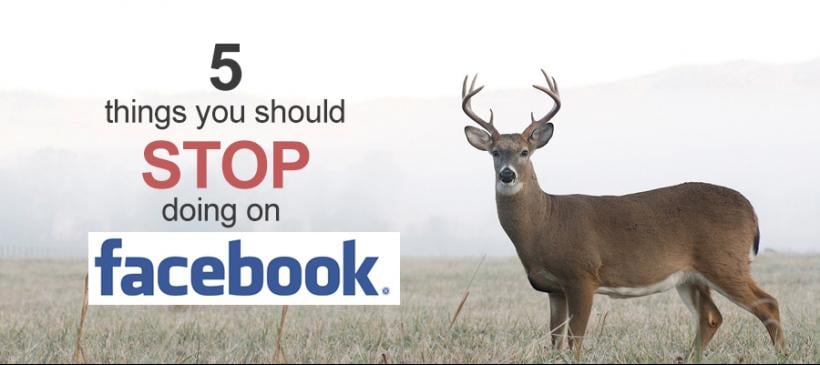5 THINGS TO STOP DOING ON FACEBOOK IN 2018
- January 24, 2018
- By Adam Preston
- Marketing

Facebook is not going away. Brands and businesses have yet to find an easier, cheaper (it’s free!) and more effective way of reaching tens of thousands of followers and customers.
Unfortunately, some people in the outdoors industry will never understand how to use social media to bridge the gap between a business and a community.
With these points in mind, add the following five STOP phrases to your list of New Year’s resolutions when it comes to managing your brand’s Facebook page.
1. Stop Posting Random Content
That’s a tough resolution to keep if you’re like every other brand out there and are doing everything pretty much by yourself. If you are, you need to stop that, too — it’s time you either invest in another employee or at least delegate your day-to-day Facebook tasks to someone on your staff.
Weeding out random content means putting an end to the food-plate selfies; your personal thoughts on why the Atlanta Hawks suck this season; and by all means the passive-aggressive political jabs at Democrats or Republicans. This isn’t to say that none of these strategies produce likes, shares and comments — they certainly can drive engagement among like-minded individuals. That’s the key word: individual. Remember, this is about extending your brand, and that includes an individual’s brand.
Consistent messaging is key to extending any brand’s scope. Develop that consistency by first identifying what it is exactly you’re trying to promote (an archery pro shop, a cooler company, an apparel line, etc) and then devising a content schedule for the entire year. The schedule can be as easy as loose monthly themes or as specific as weekly categories.
From there, curate content to fill these holes. That’s not easy, because you might need a couple hundred items to get you through the year. To make it more manageable, rely on your Facebook fan base. Curate the best content they have produced, and share it with your audience. This could include blog posts, videos, photos and other linkable items that will provide value while at the same time reminding your fans that you indeed have your thumb on their collective pulse.
2. Stop Using Irrelevant Hashtags
Most people don’t “get” hashtags. The general consensus out there is that hashtags are cutesy ways of emphasizing a message on any social media platform. And, because Twitter was the king of hashtags for years, a lot of folks believe they are platform-specific punch lines. They’re neither. Hashtags not only help a brand identify its voice on social media, they help separate the brand from its competitors.
On Facebook, especially in 2017, hashtags became the new “thing” among all brands across the hunting, shooting and outdoor sports communities. The main problem is Facebook admins everywhere struggled with not only knowing how to use them but when to use them. Here’s a fictitious example:
Here’s a sneak peek at our new hunting bow for next year! #BooYah #Bowhunting #TimeToPutTheSmackDown on some #bigbucks
OK, a little over-the-top, but you get the idea. Of the four hashtags in that post, only two are relevant — bowhunting and big bucks — but even those aren’t very good. True, if you’re in the hunting space, bowhunting and big bucks are the interest areas where you want your message to go, but it’s a virtual sea of competition out there. It would be better to use your best categories and then create a unique hashtag of your own that will eventually resonate with your future customers.
Prime examples of community hashtags that have gained traction for outdoors brands include Sportsman Channel’s #IAMSPORTSMAN, ScentBlocker’s #ShowTheShield and Weston’s #HuntHarvestEat.
Take some time in thinking of some custom hashtags for your brand and deploy them judiciously. Above all, a hashtag should reflect your brand’s voice. When you get one (or several) that work, use them consistently with everything you post on Facebook — and other social media platforms.
3. Stop Tagging Other Brands in Your Posts
That’s right, I said stop doing this, even though it flies in the face of just about everything else you’ve read about marketing to and with other businesses on Facebook.
The idea is simple enough: Tag other like-minded brands within my brand’s posts, and you’ll double, triple or quadruple your reach. It sometimes works that way, but if you do it with any kind of consistency (hence the warning), Facebook picks up on it (in a hurry, I might add), and you’ll soon see diminished results. Facebook will never admit this, but tagging other brands in your posts (especially with the newer branded content tool) creates a profile within an algorithm. Long story short, the algorithm detects what you’re trying to do (leverage) and drops your Reach to next-to-nothing unless you pay for a boosted post. It gets even more complicated than that, but the easiest way around it is to deploy other strategies.
If part of your Facebook strategy is to leverage partners and like-minded brands, do more straight-up sharing of their content, work out a deal with them for direct upload barters, or simply tag them in a comment below the original post. Comment tags are a less glorified way of sharing a post and are less likely to be picked up by algorithms.
4. Stop Thinking That It’s All About You
It doesn’t matter how large your Facebook platform may or may not be — if you’re not engaging in the conversation, you’re hurting your brand. Engagement comes in many forms, and all of them require that you roll up your sleeves and get down in the weeds, so to speak, and truly interact with your fans and followers.
There are many ways to show that your brand truly cares about its customers: Reply to every comment on your posts; comment on posts relevant to your area of expertise; like your fans’ posts; the list goes on and on. You will know how you’re doing by simply monitoring the “Reach” on your posts. Track these numbers through your page’s “Insights” feature. The higher your Reach, the more engaged your brand is becoming with its fan base. Low Reach numbers are a clear indicator that people have tuned you out because you aren’t providing anything of real substance on your page. Low Reach numbers can be fixed, but it takes time and, more importantly, a dedicated approach to both engagement and content curation.
5. Stop Ignoring Your Followers / Customers
It doesn’t matter if you’re a retailer, distributor, wholesaler or something completely different, if you continually ignore your Facebook followers, you will lose them — and their business. Chew on these stats:
•More than 34 percent of American consumers say they use social media as their top choice for a starting point when engaging with a brand’s customer service department.
•Nearly 89 percent of all brands either ignore Facebook instant messages or have configured their account settings to not accept IMs.
•When ignored by a brand, 1 in 3 consumers will turn toward one of that brand’s competitors.
The lesson: Your brand’s Facebook page is a direct extension of your business. If nothing else, view it as a free website that will help you reach new audiences. A portion of that audience will want to get ahold of you. You need to be ready, willing and able to answer the call.
Editor’s Note: This is the first of a three-part series on ways to improve your business in 2018. Check back soon for Part 2, which will provide some insight into appealing to one of the fastest-growing outdoors demographics: women hunters.
Related Article:

5 THINGS YOU SHOULD KNOW BEFORE HIRING SOCIAL AMBASSADORS FOR YOUR BRAND
